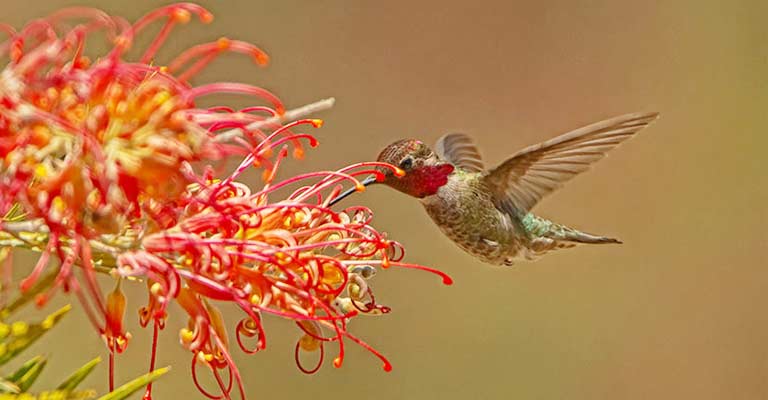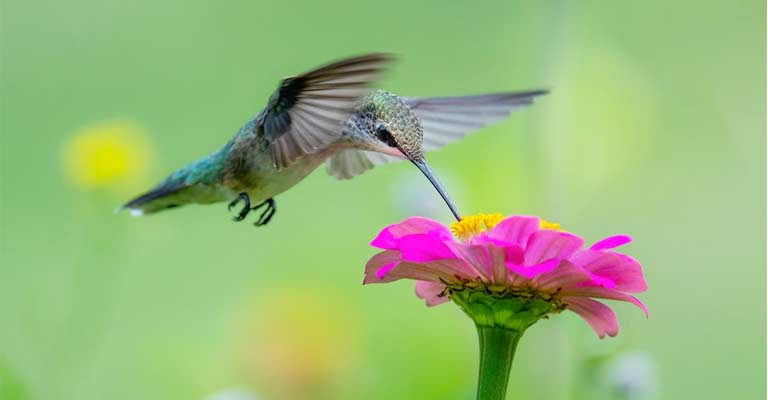In the vibrant tapestry of nature, few sights are as enchanting as the delicate dance of hummingbirds amidst a garden adorned with flowers.
The allure of these tiny, iridescent creatures is heightened when you understand the power of selecting the right blooms.
Common flowers that attract Hummingbirds act as nature’s invitation, drawing these agile birds with vibrant colours and sweet nectar.
From the elegant spires of Salvia to the cascading trumpets of Fuchsia, the choices are diverse and captivating.
This curated selection of flora not only enhances the visual charm of your garden but also creates a harmonious ecosystem where these winged wonders thrive.
Join us on a journey through the botanical delights that beckon hummingbirds, turning your outdoor space into a haven of natural beauty and avian fascination.

7 Common Flowers That Attract Hummingbirds
Hummingbirds are fascinating and beautiful creatures known for their vibrant plumage and rapid wing beats. Attracting these small, agile birds to your garden can be a rewarding experience.
One effective way to invite hummingbirds is by planting flowers that appeal to their keen sense of colour and nectar. Here are some common flowers that are sure to attract hummingbirds
1. Salvia (Salvia spp.)

Salvia, also known as sage, boasts tubular flowers that hummingbirds find irresistible. With its long bloom period and diverse colours, including reds, purples, and pinks, Salvia provides a reliable source of nectar.
Its tall spikes make it easy for hummingbirds to feed, making Salvia a popular choice for bird-friendly gardens.
2. Trumpet Vine (Campsis radicans)

The Trumpet Vine produces large, trumpet-shaped flowers in vibrant shades of orange and red. The tubular shape of the blossoms is perfectly suited for hummingbirds to insert their slender bills.
This hardy, fast-growing vine is an excellent choice for attracting hummingbirds due to its abundance of nectar.
3. Bee Balm (Monarda spp.)

Bee Balm, also known as Monarda or Bergamot, features colourful, spiky blooms that hummingbirds find appealing. The tubular flowers come in various shades, including red, pink, and purple.
Beyond attracting hummingbirds, Bee Balm is valued for its pleasant fragrance and its ability to attract butterflies to your garden.
4. Fuchsia (Fuchsia spp.)

Fuchsia plants are renowned for their pendulous, tubular flowers that often display a striking combination of colours, such as pink and purple. Hummingbirds are drawn to the nectar-rich blossoms, and the unique shape of the flowers allows these birds easy access to the sweet reward within.
Hanging baskets or container gardens with Fuchsia can be particularly attractive to hummingbirds.
5. Columbine (Aquilegia spp.)

The delicate and intricate flowers of Columbine are a favourite of hummingbirds. These unique blossoms feature long spurs that contain nectar, enticing hummingbirds to hover and feed.
Columbine comes in various colours, and its graceful appearance adds an enchanting touch to any garden.
6. Lantana (Lantana camara)

Lantana is a versatile flowering plant that produces clusters of small, tubular flowers in hues of red, orange, yellow, and pink. Hummingbirds are attracted to the abundant nectar, and the continuous blooming nature of Lantana ensures a prolonged food source for these delightful birds.
7. Honeysuckle (Lonicera spp.)

Honeysuckle vines are known for their fragrant and tubular flowers that hummingbirds find irresistible. The sweet nectar of the blossoms is a magnet for these agile birds.
With varieties ranging from red to orange to pink, Honeysuckle adds both visual appeal and a hummingbird-friendly environment to your garden.
Which Flowers Do Hummingbirds Don’t Like?
While attracting hummingbirds to your garden can be a delightful experience, it’s equally important to be aware of flowers that may not appeal to these tiny, nectar-loving birds.
Here are some flowers that hummingbirds are less likely to be drawn to:
Petunia (Petunia spp.)
Petunias, with their trumpet-shaped flowers, may seem like a good choice for hummingbirds, but they are less attractive due to their relatively mild nectar.
Hummingbirds are more inclined toward flowers with higher nectar content, so petunias may not be their first choice in a garden.
Impatiens (Impatiens spp.)
Impatiens, known for their vibrant and abundant blooms, are not a top pick for hummingbirds. While these flowers offer a burst of colour, their structure doesn’t cater to the feeding habits of hummingbirds, who prefer tubular flowers that allow easy access to nectar.
Geranium (Pelargonium spp.)
Geraniums, with their dense clusters of flowers, are not particularly appealing to hummingbirds. The shape and arrangement of geranium blossoms make it challenging for hummingbirds to access the nectar easily, leading them to opt for more accessible sources.
Begonia (Begonia spp.)
Begonias, prized for their lush foliage and colourful blooms, do not stand out as hummingbird magnets. The shape of begonia flowers, often in the form of tight clusters, makes it less convenient for hummingbirds to feed, steering them towards more accommodating options.
Zinnia (Zinnia spp.)
Zinnias, though popular for their vibrant and diverse colours, are not the first choice for hummingbirds. The structure of zinnia flowers, with their broad, flat petals, does not align with the preferences of hummingbirds, who favour tubular shapes that allow for efficient nectar extraction.
Marigold (Tagetes spp.)
Marigolds, known for their resilience and bright hues, are not high on the list of hummingbird-attracting flowers. The form of marigold blooms, often composed of numerous petals, doesn’t provide the convenient nectar access that hummingbirds seek in their foraging endeavours.
Alyssum (Lobularia maritima)
While alyssum adds a delicate, sweet fragrance to gardens, it is not a top choice for hummingbirds. The small, compact flowers of alyssum don’t offer the tubular shape that hummingbirds prefer, making them less likely to visit in search of nectar.
What Are The Best Fake Flowers To Attract Hummingbirds?

While live flowers are the preferred choice for attracting hummingbirds due to their nectar content, some artificial alternatives can mimic the visual appeal of real blooms.
Here are some fake flowers that can attract hummingbirds:
Artificial Salvia (Fake Salvia spp.)
Fake Salvia replicas capture the distinctive tubular shape and vibrant colours of real Salvia flowers, making them visually appealing to hummingbirds.
These artificial blooms provide a low-maintenance alternative while maintaining the aesthetic charm that hummingbirds find attractive.
Imitation Trumpet Vine (Fake Campsis radicans)
Artificial Trumpet Vine replicas mimic the large, trumpet-shaped flowers in vivid hues, emulating the visual allure that attracts hummingbirds.
These fake blossoms can be strategically placed to create a hummingbird-friendly atmosphere in your garden without the need for regular care.
Faux Bee Balm (Artificial Monarda spp.)
Imitation Bee Balm reproduces the spiky, colourful blooms that hummingbirds are drawn to. These artificial flowers offer a long-lasting solution for attracting hummingbirds, and their realistic appearance adds a lively touch to your garden without the need for watering or sunlight.
Fake Fuchsia (Imitation Fuchsia spp.)
Artificial Fuchsia replicas capture the pendulous, tubular shape and vibrant hues of real Fuchsia flowers. These faux blooms provide a durable and maintenance-free option to attract hummingbirds to your garden, creating a visually enticing environment.
Artificial Columbine (Fake Aquilegia spp.)
Imitation Columbine reproduces the delicate and intricate flowers that hummingbirds love. These artificial blooms can be strategically placed to simulate a natural garden setting, attracting hummingbirds without the need for the care associated with live plants.
Faux Lantana (Artificial Lantana camara)
Artificial Lantana replicas emulate the clusters of small, tubular flowers in a variety of colours. These fake blooms offer a durable and vibrant alternative to live Lantana, ensuring a visually appealing display that can attract hummingbirds to your garden.
Imitation Honeysuckle (Fake Lonicera spp.)
Artificial Honeysuckle replicas capture the fragrance and tubular shape of real Honeysuckle flowers. These fake blooms provide a maintenance-free solution for creating a hummingbird-friendly space in your garden, adding charm and colour without the need for care.
While artificial flowers lack real nectar, these replicas can still serve as attractive visual stimuli for hummingbirds. Strategically placing them in your garden can create a welcoming environment, giving you the pleasure of observing these delightful birds without the upkeep associated with live plants.
Faqs
Do all hummingbird-attracting flowers need full sunlight?
While many hummingbird-friendly flowers thrive in full sunlight, some, like Coral Honeysuckle, tolerate partial shade. It’s essential to consider the specific needs of each plant and provide the right conditions for optimal blooming and nectar production.
How can I extend the blooming period of hummingbird-attracting flowers?
To prolong the blooming season, choose a variety of flowers with staggered bloom times. Additionally, deadheading—removing spent flowers—encourages continuous blooming by redirecting the plant’s energy to new bud production, ensuring a steady supply of nectar.
Are there low-maintenance flowers that still attract hummingbirds?
Yes, several low-maintenance options attract hummingbirds, such as Lantana and Daylilies. These hardy plants require minimal care while providing continuous blooms, making them ideal for busy gardeners who still want to enjoy the presence of hummingbirds.
Can container gardening be effective in attracting hummingbirds?
Absolutely! Container gardens with flowers like Trumpet Vine, Petunias, and Salvia are effective in attracting hummingbirds. Ensure the containers have proper drainage and select a sunny location to create a hummingbird-friendly oasis even in limited outdoor space.
Do native plants attract more hummingbirds than non-native ones?
In many cases, native plants are well-adapted to local conditions and may offer more benefits to native wildlife, including hummingbirds. However, some non-native flowers, like Fuchsia and Bee Balm, can still be highly attractive and provide a valuable nectar source for hummingbirds in your garden.
Conclusion
In cultivating a garden that beckons hummingbirds, we find ourselves weaving a tapestry of life that goes beyond the aesthetic.
The common flowers discussed are not mere ornaments but essential elements that sustain the delicate ballet between flora and fauna.
As we conclude this exploration of nature’s invitation, envision the joy of witnessing hummingbirds flit gracefully among the blooms you’ve chosen.
The vibrant Salvia, the pendulous Fuchsia, and their floral companions contribute not only to the visual splendour of your garden but also to the broader harmony of the natural world.
By planting these common flowers that attract hummingbirds, we celebrate the interconnectedness of life, transforming our outdoor spaces into sanctuaries where beauty and biodiversity coexist in a delicate dance of colour and flight.